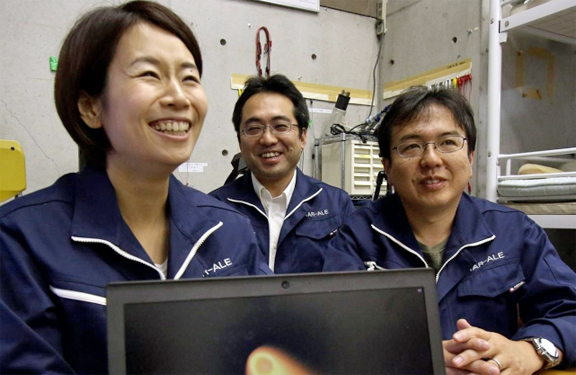[SatNews] Fancy a meteor shower racing across the night sky to mark your birthday?
One Japanese start-up is hoping to deliver shooting stars on demand and choreograph the cosmos. And, say scientists, it's not just about painting huge pictures on the night-sky that would be visible to millions of people; artificial meteors could help us to understand a lot more about Earth's atmosphere.

Pictured, left, is Lena Okajima, the CEO of ALE during a presentation in Tokyo.Lena Okajima, who holds a doctorate in astronomy, says her company—ALE—is intending to launch a micro satellite that can eject shooting stars at exactly the right time and place to put on a celestial show.
"I'm thinking of streams of meteors that are rare in nature," Okajima told AFP in an interview. "It is artificial but I want to make really beautiful ones that can impress viewers," she said.
In collaboration with scientists and engineers at Japanese universities, the ALE team is developing a satellite that will orbit the Earth and eject dozens of balls, a few centimetres (an inch) in diameter, at a time. These balls, whose chemical formula is a closely-guarded secret, will race through the atmosphere at around 7-8 kilometers (up to five miles) a second, glowing brightly from the friction created by smashing into the air.
Although it sounds fast, that is considerably slower than naturally-occurring meteors—chunks of material that either broke away from a planet or never managed to form one in the first place—which can hurtle through the atmosphere at up to 80 kilometers a second.
Tinkering with the ingredients should mean that it is possible to change the color of each bright streak, says Okajima, offering the possibility of a multi-colored flotilla of shooting stars. The stars are expected to shine for several seconds before they are completely burned up, well before they fall low enough to pose any danger to anything on Earth.
"People may eventually become tired of seeing shooting stars if they come alone. But they could be coupled with events on the ground," Okajima said. "Making the sky a screen is this project's biggest attraction as entertainment. It's a space display."
Tests on the secret formula space pellets carried out with Shinsuke Abe, aerospace engineering associate professor at Nihon University, show they would even burn brightly enough to be seen over the light-polluted metropolis of Tokyo. Unless, of course, it's cloudy. However, says Okajima, the release can be called off up to 100 minutes before the appointed launch—perhaps allowing party organizers to reschedule for another night when the weather is better.
Beautiful it might be, but it won't come inexpensively; each shooting star would cost around a million yen ($10,800), as the company tries to make back more than one billion yen price tag for the development and launch of the micro satellite. That satellite, which is currently at the design stage, is a 50 centimeter (20 inch) cube that will orbit the Earth at an altitude of around 400 to 500 kilometers (250-310 miles), on a north-south heading. The satellite will only have a limited lifespan, says aerospace engineer Takeo Watanabe of Teikyo University, explaining that after a few months it will crash through the atmosphere and burn up in a blaze of light.
For Hironori Sahara, associate professor at Tokyo Metropolitan University's aerospace engineering department, the project offers a rare chance to observe a part of the atmosphere about which little is known. The altitude at which the artificial stars will burst to life—above 60 kilometers up—is too high for balloons and too low for spacecraft, so it is difficult to study. If ground-based observers know exactly when and where meteors will appear, something they simply cannot know at the moment, despite regular showers giving an idea, they will be able to train their equipment on the spot. Close analysis of the light and the trail would reveal the temperatures and densities of the atmosphere and its movements, and could give clues on how the environment will change over the medium and longer term, Sahara said. Comparisons with artificial meteors could also shed light on what natural shooting stars are made of, he said.
The combination of a paid-for product and genuinely useful science could blaze a trail for researchers looking to fund their work without using taxpayers' money, said Sahara. ALE has been talking with "individual investors," but does not intend to limit its future clientele, who could range from millionaires and science teams to corporate giants and groups of fun-seekers.
"We believe there are people who would be ready to put up money for supporting 'a world first' event that is also meaningful scientifically," Okajima said.
Story by SPH Digital News / AsiaOne Group